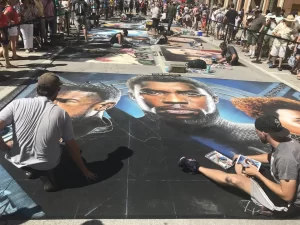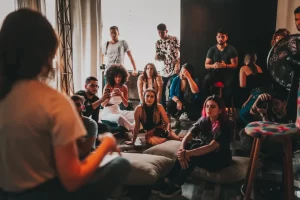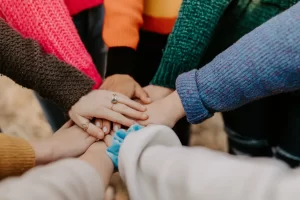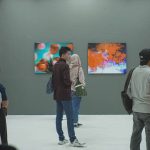Introduction to Art Community Engagement
Art Community Engagement: Fostering Creativity, Connection, and Social Impact
Art community engagement is a dynamic and transformative process that goes beyond the canvas, transcending traditional boundaries to create a vibrant tapestry of shared experiences. In this article, we delve into the layers of art community engagement, exploring its definition, forms, importance, challenges, and successful examples across three generations of creative interaction.
Engaging the art community also acts as a catalyst for constructive social change. Communities can tackle urgent issues, give voice to underrepresented groups, and promote inclusivity by working together on art projects. Through artistic expression, people can use art as a tool for advocacy and empowerment to creatively convey their goals and concerns. This kind of participation goes beyond merely appreciating art; it turns art into a vehicle for activism and public discourse. The common creative experiences serve as a forum for group discussion and action, illustrating how creativity may lead to significant social change.
Additionally, the digital era has given art community interaction additional dimensions. Through social media, online platforms, and virtual places, artists and communities can connect worldwide, overcoming geographical limitations. Diverse viewpoints can come together through collaborative initiatives started on internet media, resulting in a creative melting pot. The availability of digital tools has made artistic engagement more inclusive, enabling people from all backgrounds to add to a shared virtual canvas. The incorporation of technology creates new opportunities for creative partnerships and guarantees that the transforming impact of shared artistic experiences transcends digital boundaries as we embrace the changing environment of art and community involvement.
Defining Art Community Engagement
What is art community engagement?
Art community engagement is the active participation between artists, arts organizations, and the broader community. It is about creating shared experiences and connections through art, fostering dialogue, learning, and social impact. From murals to online collectives, the scope is diverse, uniting people through a common language—art.
Diverse Expressions of Connection: A Spectrum of Possibilities
From monumental murals that breathe life into public spaces to the expansive landscapes of online collectives, art community engagement takes on a myriad of forms, each contributing to the creation of shared narratives and fostering a sense of unity. It extends beyond the confines of traditional art, embodying a celebration of diversity and acting as a conduit for dialogue and understanding.
Fostering Dialogue and Learning: A Continuous Exchange
Art community engagement is not just about the creation of visually stunning murals or the formation of virtual art communities; it is a catalyst for dialogue and learning. It sparks conversations, encourages the exchange of ideas, and serves as a platform for continuous education. Through this engagement, individuals are not just spectators but active participants in the evolution of cultural narratives.
Creating Social Impact: A Transformative Force
At its core, art community engagement is a force for social impact. It is a powerful tool that artists and communities leverage to address pressing social issues, amplify voices that are often unheard, and instigate positive change. The transformative potential of this engagement extends beyond the realm of aesthetics, making art a vehicle for advocacy and a medium to challenge societal norms.
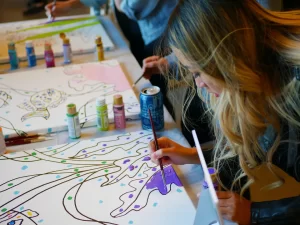 Rahul Jain
Rahul JainDifferent forms of art community engagement
Collaborative Art Projects
Collaborative art projects serve as vibrant expressions of collective creativity, ranging from awe-inspiring murals adorning city walls to interactive public art installations and designated community art spaces. These endeavors not only beautify physical spaces but also become living testaments to the power of collaborative creation, reflecting the unique identities and narratives of the communities involved.
Art Outreach Programs
Art outreach programs extend the transformative potential of art into diverse settings, creating bridges between artistic expression and communities. From school initiatives that nurture creativity in young minds to art programs in hospitals and underserved communities, these outreach efforts ensure that art becomes a conduit for inclusivity, education, and empowerment.
Artist Residencies and Workshops
Artist residencies and workshops form the educational backbone of art community engagement. These initiatives provide dedicated spaces for artists to immerse themselves in their craft, fostering an environment conducive to creativity and exploration. By nurturing creativity through educational initiatives, these programs play a pivotal role in shaping the future of artistic expression within communities.
Social Media Platforms and Online Art Collectives
In the digital age, art community engagement transcends geographical boundaries through social media platforms and online art collectives. These virtual spaces serve as global hubs where artists from diverse backgrounds connect, collaborate, and exchange ideas. The interconnectedness of these platforms creates a dynamic and inclusive global community, redefining the traditional boundaries of artistic collaboration.
Advocacy and Activism Through Art Forms
Art becomes a powerful tool for advocacy and activism through forms that harness creativity for social change. Whether through visual arts, performances, or multimedia expressions, this form of engagement amplifies voices, challenges societal norms, and addresses pressing social issues. It transforms art into a catalyst for positive change, sparking conversations and inspiring action within communities.
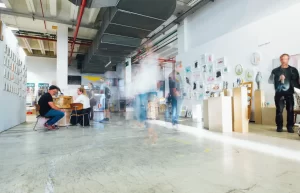 Markus Spiske
Markus SpiskeImportance of Art Community Engagement
Benefits for Artists: Spotlight and Growth
Engaging with the community propels artists into the spotlight, increasing visibility, audience engagement, and potential funding. It serves as a wellspring of creative inspiration, fosters artistic development, and builds meaningful connections and collaborations.
Art community engagement serves as a powerful catalyst for artists, propelling them into the spotlight of visibility and recognition. The engagement with the community not only broadens their audience base but also enhances engagement and potential funding opportunities. Beyond the pragmatic aspects, it acts as a wellspring of creative inspiration, fostering the artist’s development and opening doors to meaningful connections and collaborations that transcend the confines of the studio.
Exploring Artistic Frontiers: Continuous Inspiration and Development
Engaging with the community offers artists a continuous source of inspiration, pushing them to explore new artistic frontiers. Interacting with diverse audiences and their unique perspectives provides fresh insights that can fuel innovative ideas and approaches. This ongoing dialogue nurtures artistic development, encouraging artists to evolve and adapt their practices in response to the ever-changing cultural landscape.
Building Meaningful Connections: Collaborative Endeavors with Community
Through dynamic exchanges, artists and the communities they interact with can forge lasting relationships. Art community involvement is not just a one-way highway. In order to access the rich fabric of local histories, experiences, and stories, artists must engage in collaborative initiatives. These ties foster a sense of shared ownership and duty that goes beyond transactional interactions.
Challenges and Considerations
Identifying and engaging diverse communities
Reaching diverse communities requires thoughtful strategies and an understanding of their unique needs and interests. Tailoring engagement initiatives to be culturally sensitive and inclusive is paramount.
To effectively engage diverse communities, it’s essential to move beyond surface-level differences and embrace a holistic understanding of their varied needs, interests, and cultural nuances. Recognizing the richness within each community fosters a more authentic connection, laying the groundwork for meaningful engagement initiatives.
Engaging with diverse communities is not a one-time effort but an ongoing, dynamic process. Establishing channels for continuous feedback and being receptive to the evolving needs of the community allows for adaptation and refinement of engagement strategies. This iterative approach ensures that initiatives remain relevant and responsive to the changing dynamics within diverse communities.
Ensuring accessibility and inclusivity in art programs
Accessibility is key to successful engagement. Whether physical or digital, art programs must be designed to accommodate a wide range of abilities, ensuring everyone can participate.
Art has the power to transcend language barriers and connect people from different walks of life. Therefore, incorporating a variety of artistic styles, themes, and traditions in program content can create a more inclusive environment. This may involve collaborating with artists from various cultural backgrounds, showcasing diverse artworks, and encouraging participants to explore their own cultural influences in their artistic expressions.
Encouraging diversity and accessibility in art programs necessitates taking proactive steps to eliminate socioeconomic hurdles that can prevent participation. Making art education more affordable for people with little resources can be accomplished by providing scholarships, reduced-cost supplies, or even free classes. Collaborations with neighborhood community organizations and educational institutions can help art programs reach a wider audience and guarantee that people from all backgrounds can participate in creative endeavors. Art programs can become truly transforming and enlightening experiences for all those engaged if these many aspects of accessibility and inclusivity are actively considered and addressed.
Building sustainable partnerships and funding models
Sustainability is crucial for the longevity of engagement initiatives. Building strong partnerships and exploring innovative funding models can ensure ongoing support for community-centered art projects.
Incorporating sustainable practices within the execution of art programs is vital for minimizing environmental impact. Adopting eco-friendly materials, encouraging recycling, and promoting responsible waste management can contribute to the overall sustainability of these initiatives. By prioritizing environmentally conscious choices, art programs not only demonstrate a commitment to ecological well-being but also inspire participants to integrate sustainable practices into their creative processes.
Establishing mechanisms for ongoing feedback, collaboration, and involvement from the community ensures that art programs remain relevant and responsive to the changing needs and aspirations of the people they serve. This participatory approach fosters a sense of ownership within the community, creating a sustainable framework where residents actively contribute to and shape the direction of artistic endeavors. In essence, sustainable community-centered art projects go beyond short-term engagements, laying the groundwork for enduring relationships and the continued growth of a vibrant and connected community through the medium of art.
Measuring the impact and effectiveness
Measuring the impact of community engagement initiatives is challenging but essential. Developing clear metrics and assessment tools helps evaluate effectiveness and guide future endeavors.
To gauge the impact of community engagement initiatives, it is crucial to establish both quantitative and qualitative metrics that align with the specific goals of the art programs. Quantitative measures may include attendance rates, participant demographics, and changes in community dynamics, while qualitative assessments can delve into individual stories, testimonials, and the perceived cultural impact. Combining these metrics provides a comprehensive understanding of the initiative’s reach and influence.
Ongoing feedback mechanisms and regular evaluations allow for continuous improvement. Regular surveys, focus group discussions, and reflective sessions with participants, artists, and community stakeholders provide valuable insights into the strengths and areas for development within the engagement initiatives. This iterative process not only informs future programming but also fosters a sense of transparency and accountability, demonstrating a commitment to learning and adapting based on community needs.
Conclusion
Art community engagement stands as a dynamic force, seamlessly connecting artists, communities, and the broader art landscape. It goes beyond mere interaction; it enriches lives, nurtures creativity, and catalyzes positive social change. Calling upon artists, organizations, and communities alike, it’s time to actively participate. Embrace the transformative power inherent in art community engagement and become integral to a movement that not only embraces but actively shapes the future through creativity, meaningful connections, and shared experiences.
In embracing the transformative power of art community engagement, we collectively contribute to a movement that goes beyond the canvas or stage. It becomes a movement of shared stories, diverse perspectives, and collaborative endeavors that actively shape the future. Through creativity, meaningful connections, and shared experiences, we have the opportunity to build a more compassionate, inclusive, and culturally rich society, where the arts serve as a driving force for positive social change.
Key Takeaways
| Key Points | Takeaways |
| Definition of Art Community Engagement | Active participation, shared experiences, and social impact. |
| Forms of Engagement | Murals, outreach programs, residencies, and online collectives. |
| Benefits for Artists | Increased visibility, creative inspiration, and collaborations. |
| Benefits for Communities | Cultural enrichment, a sense of belonging, and social change. |
| Benefits for the Art World | Expanded audience, inclusivity, and demonstrated impact. |
| Challenges and Considerations | Diverse engagement, accessibility, and sustainability. |
| Examples of Success | Mural Mile, Art in Education, Online Artivism Collective. |
| Conclusion and Call to Action | Recap of importance; call for involvement in engagement. |
Frequently Asked Questions
How can individual artists contribute to community engagement?
Individual artists can contribute by participating in local projects, offering workshops, or using their art for advocacy, bringing their unique perspective to community needs.
What role does technology play in art community engagement?
Technology facilitates online collectives, virtual exhibitions, and digital campaigns, enabling artists to connect with global audiences and engage communities beyond physical boundaries.
How can communities initiate their own art engagement projects?
Communities can start by identifying local needs, collaborating with artists, and seeking support from local organizations. Grassroots initiatives often begin with a shared vision and determination.
What impact does art community engagement have on mental health?
Art community engagement can have positive effects on mental health by providing a creative outlet, fostering a sense of belonging, and promoting social connections and support.
How can organizations measure the success of their community engagement initiatives?
Organizations can measure success through metrics such as increased participation, community feedback, and the tangible impact on the community, whether through tangible outcomes or qualitative indicators.


